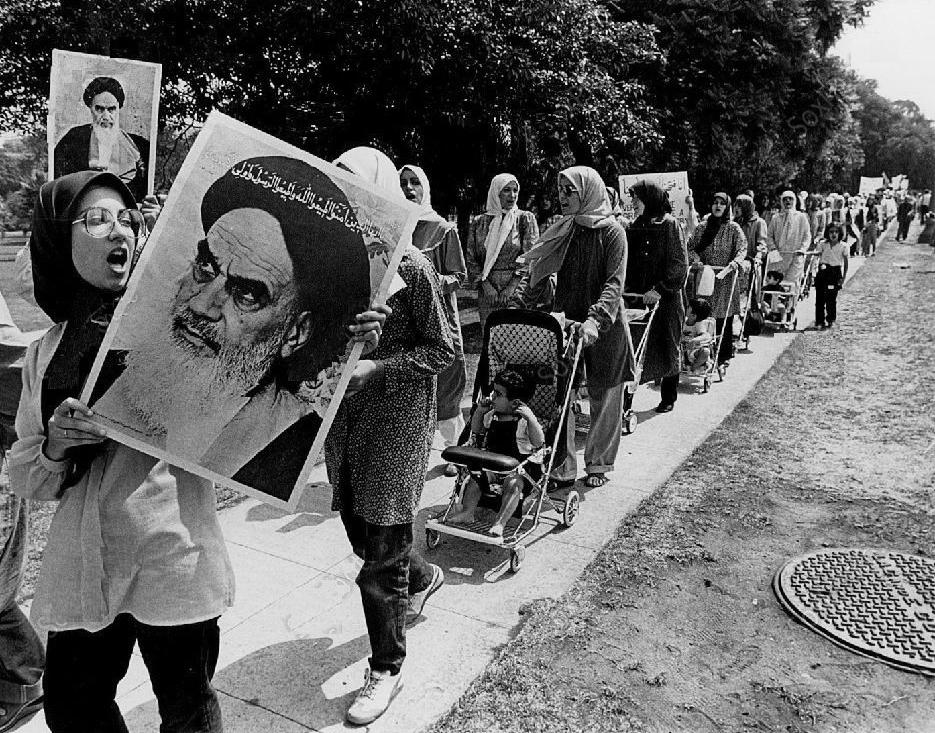
Iranian History: Overthrow of the Shah (1978-79)

Figure 1.--Here Iranian women demonstrate theur support for the Ayatollah Khomeini. Ironically women were among the greatest beneficiaries of the Shah's modernization efforts. We think this photograph was taken in Los Angeles during 1978. America media at the time was highly critical of the Shah, basically camparing it unfavoravly to the standards of Western democracy.
|
|
The Shah's Governent with oil income made impressive advances in modrnizing Iran which athe tome of World war II waa a still very poor and backward country, only minimally touched by the modern world and technology. Conservative Iranian society found some of the modrnization efforts profoundly disturbing, especially the lack of focus on Islam and the Western values such as women's rights. What was not part of the shah's modernization program was creating a modern democratic society. SAVAK was used to supress all political oppisition. They might have supported a constitutionl monarchy. As a result, opposition to the Shah increased. It was not just from the powerful religious community, but from the new educated, urban middle class that the Shah's program had helped create. Even young women who were being educated for the first time were among the Shah's critics. The Shah became seen as not only corrupt, but beholden to Western imperialists, both the British and Americans. Many Iranians believed that the national oil boom, wealth was not being equally distributed. It is not clear, however, if this actually imprived by the Islamists ho seized control after the oberthrow of the Shah. Pprotests grew in Iran despite the represive measures of SAVAK. Some Iramians wanted to replace the Shah with a new democratic parlimentary system based on the majlis. The most powerful movement, however, became the Islamists which ould demand a more Muslim way of life (tabriz) and respect the religious clerics (ulama). The country by 1978 was moving toward civil war. Ayatollah Khomeini living in exile in France led the opposition to the Shah. While the Shah's government controlled media, Khomenini managed to circulate his message through tape cassettes which were smuggled into Iran and then duplicated in large numbers. In this fashion they were circulated throughout the country. Protests increased. And the Army was rediddled with young conscripts and officers who wre attracted by Ayatollah Khomeini preaching. Finally the Shah's government cn no longer control the situation. The Shah finally was forced from Iran (January 16, 1979).
CIH

Navigate the Children in History Web Site:
[Return to Main Iranian Revolution page]
[Return to Main Iranian history page]
[Return to Main 21st century specific war essay page]
[Return to Main specific war essay page]
[Return to Main revolutins page]
>[Introduction]
[Biographies]
[Chronology]
[Climatology]
[Clothing]
[Disease and Health]
[Economics]
[Geography]
[History]
[Human Nature]
[Law]
[Nationalism]
[Presidents]
[Religion]
[Royalty]
[Science]
[Social Class]
[Royalty]
[Bibliographies]
[Contributions]
[FAQs]
[Glossaries]
[Images]
[Links]
[Registration]
[Tools]
[Boys' Clothing Home]
Created: 7:40 AM 7/22/2017
Last updated: 7:40 AM 7/22/2017



